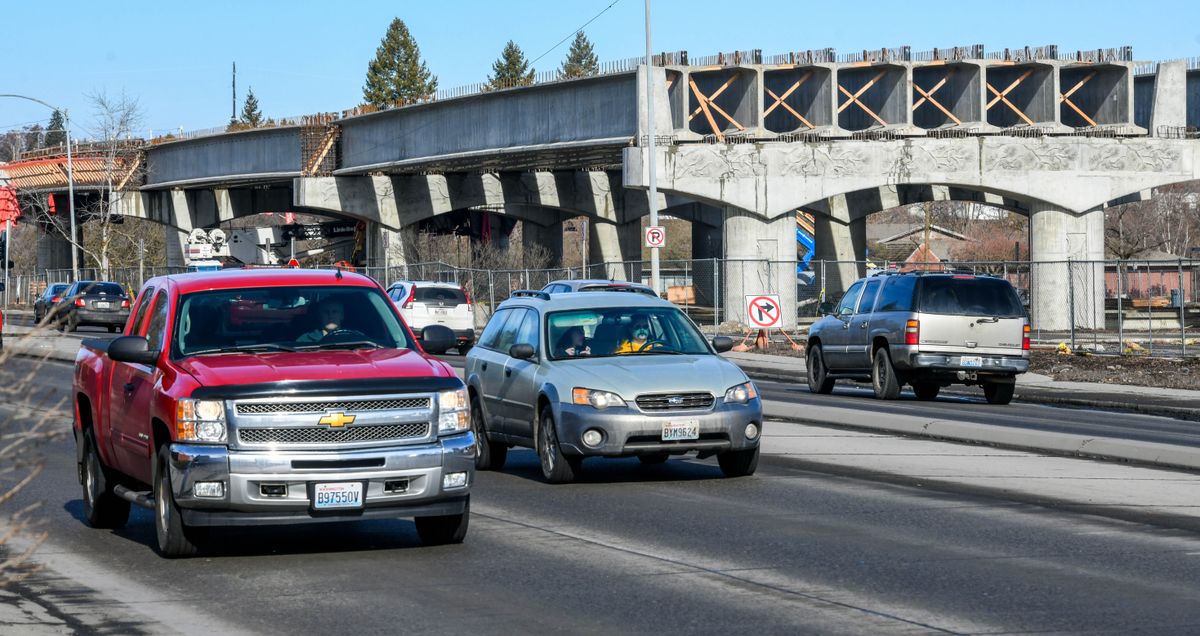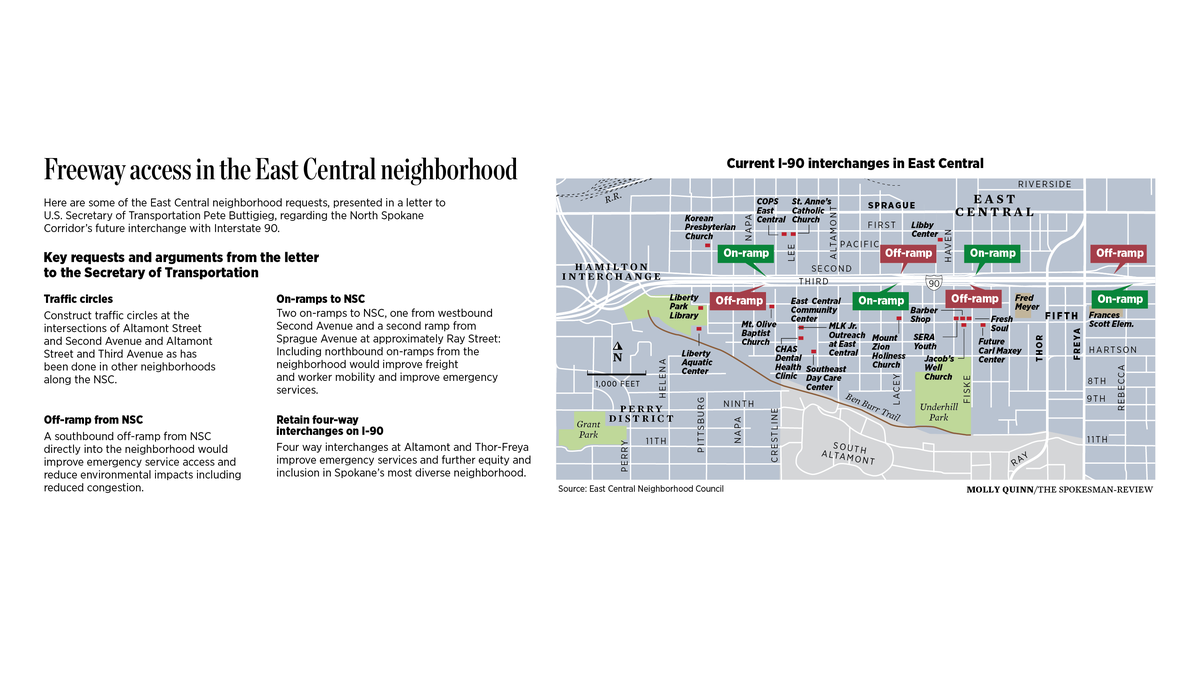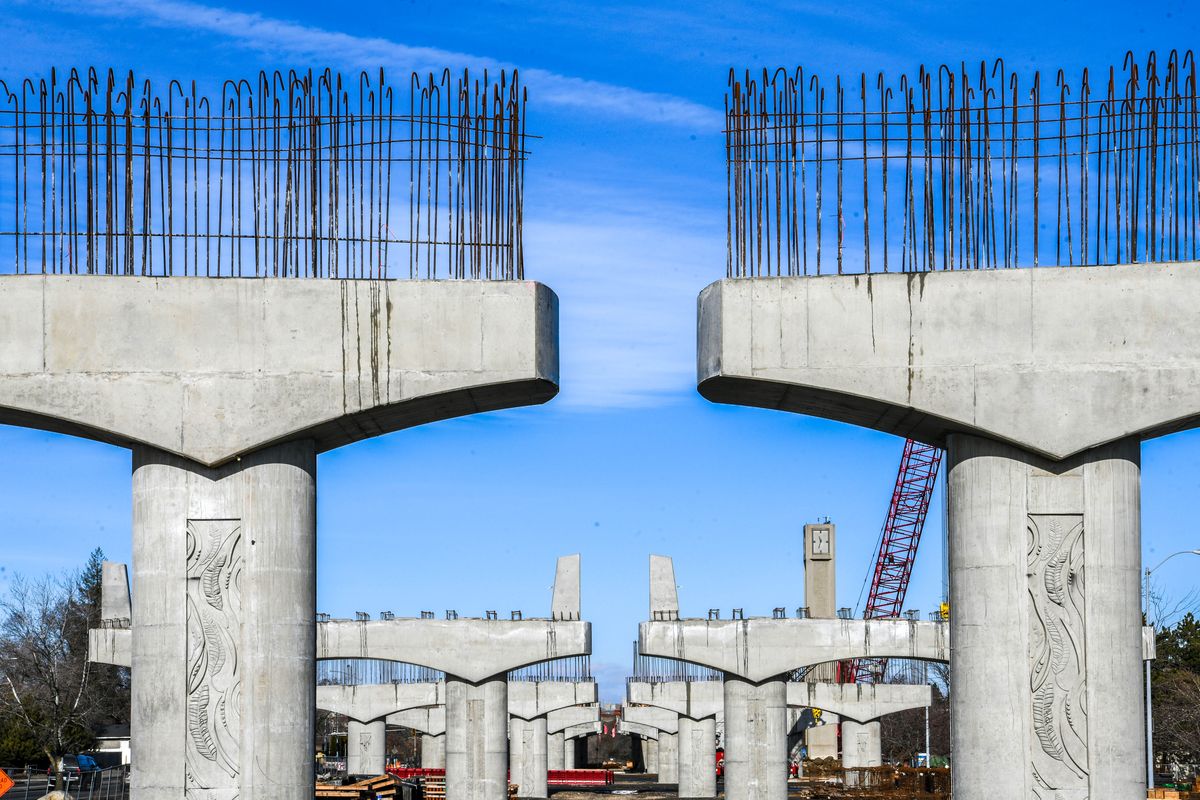Getting There: Anxious about ‘more of the same,’ East Central appeals to U.S. Transportation Secretary Pete Buttigieg on North Spokane Corridor exits
Columns rise from the Spokane Community College parking lot as construction continues on the North Spokane Corridor project Saturday. (Dan Pelle/THE SPOKESMAN-REVIEW)Buy a print of this photo
The residents of the East Central neighborhood recently took their hopes for the design of Spokane’s new freeway directly to Washington, D.C.
Randy McGlenn, the neighborhood council’s chairman, penned a letter to U.S. Transportation Secretary Pete Buttigieg in December urging the federal government to provide the same access to the new highway connecting the neighborhood to Wandermere and Highway 2 to the north of town as other homes along the highway in Hillyard and northeast Spokane.
“Mister Secretary, I ask that your department works with our state Department of Transportation along with state and local leaders to provide a solution to the apparent funding shortcomings that are impacting our neighborhood’s access to this vital infrastructure,” McGlenn wrote.
Since that letter was drafted and sent, the East Central Neighborhood Council has met with WSDOT to address those concerns and requests. Chief among them are the hope for roundabouts at critical access points and multiple northbound onramps to the new highway on Second Avenue and Sprague Avenue at Ray Street.
“As it stands presently, East Central and essentially the entire South Hill are the only stretch of this project with reduced connectivity,” McGlenn said. He pointed to the addition of two roundabouts at Wellesley Avenue in the Hillyard neighborhood, part of an underway $62 million phase of the construction that will bring U.S. 395 south to the Spokane River, as evidence of increased access that hasn’t been contemplated in East Central.
Any discrepancy between options available for access in other neighborhoods could be seen by residents as a repeat of the construction of Interstate 90, which sliced East Central in two in the 1950s and ’60s, McGlenn said.
“There’s definitely that anxiety that this is going to cause more of the same,” he said.
It is that traffic on Interstate 90 that will guide WSDOT’s determination on the design of a southern terminus for the long-gestating road project, said Ryan Overton, communications manager for WSDOT’s eastern region. Any infrastructure built in East Central is not only subject to the budget allocated by the Legislature, but also the flow of traffic on the interstate. The Federal Highway Administration requires any new building to improve, or at least maintain, traffic flow, which some of the neighborhood’s suggestions could cause.
“We are only able to do what funding will allow, what will operationally work, and what will have an overall operational benefit to the system,” Overton wrote in an email. “Even though some things we think are good ideas, some we may not be able to include based on a decrease in operation of the system and budget constraints.”
McGlenn said he understood that congestion on the highway could be a consequence of the neighborhood’s requests, but that congestion in the neighborhood should be considered, particularly the at-grade railroad crossing at Sprague Avenue and Freya Street.
“I would argue that congestion on the freeway is less hazardous than congestion in our streets and arterials, with children that are going to be crossing streets, pedestrians and bicyclists and everything else,” he said.
Overton acknowledged that plans for that portion of the highway have been scaled back in recent years. WSDOT moved away from what’s known as a “collector-distributor” type of road several years ago for a more streamlined approach that incorporates the existing road system, which Overton said resembled a trumpet.
Any final decision about what the interchange looks like is still several years out, Overton said, as WSDOT employs a “design-build” approach to what will be the final phase of a project first envisioned more than 70 years ago. That type of construction puts one firm in control of both the planning and building of a project, like what WSDOT is currently doing with the construction of the Children of the Sun Trail along the corridor through Hillyard. Such a situation allows fluidity in the design and amenities of a project as construction commences.
Meantime, the Washington Legislature has taken up the suggestion of the neighborhood that land WSDOT acquired for the larger connection be available for housing projects and other community benefits. A Senate bill sponsored by Sen. Andy Billig, D-Spokane, would direct WSDOT to allow lease of land it doesn’t need for the project to nonprofits and other entities for below-market rents for housing, parks and other community uses.
“This will be transformative, and a once-in-a-lifetime opportunity to allow effective property to be used for community purposes made unavailable due to the placement of the highway,” said Spokane City Councilwoman Betsy Wilkerson, testifying in favor of the bill at a Senate committee hearing late last month.
McGlenn said that after meeting with WSDOT in January, residents of the East Central neighborhood remain hopeful future entrance/exit plans for the highway will include their input.
“I’m hoping that working with WSDOT, the state Legislature and with other community partners here, we’ll come up with a satisfactory plan,” he said.
Work to watch for
The westbound curb lane of Boone Avenue near construction of the new downtown sports stadium will be closed between Stevens and Howard streets through Feb. 15 for Track Utilities work.
Qwest work will close the center lanes of Maple Street at its intersection with Northwest Boulevard, the westbound curb lane of Northwest Boulevard between Walnut and Ash streets, and the east curb lane of Maple Street between Jackson and York avenue in the Emerson-Garfield neighborhood beginning Wednesday through Feb. 14.
Motorists traveling beneath the Browne Street viaduct in downtown Spokane should be aware crews will be installing fencing Tuesday through Friday.
Rosamond Avenue over Interstate 90 east of the Finch Arboretum is closed. Crews are expected to make repairs to the bridge over the summer.
City crews had filled 850 potholes in Spokane as of Thursday afternoon. To report a pothole in the city, dial 311. If you’re in Spokane County, dial (509) 477-2547.


